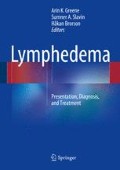Abstract
Most patients with lymphedema can be diagnosed by history and physical examination. Individuals with primary (idiopathic) disease typically present during infancy or adolescence. A family history of the condition may be present. Adults who develop lymphedema usually have secondary disease after injury to their axillary and/or inguinal lymph nodes. Patients with lymphedema often have a history of cellulitis of the extremity. Edema almost always involves the distal limb, and the skin of the hand or foot is unable to be pinched. Patients initially have pitting edema, which becomes non-pitting as fibroadipose deposition occurs.
Access this chapter
Tax calculation will be finalised at checkout
Purchases are for personal use only
References
Allen EV. Lymphedema of the extremities. Classification, etiology and differential diagnoses. A study of 300 cases. Arch Intern Med. 1934;56:606–24.
Smeltzer DM, Stickler GB, Schirger A. Primary lymphedemas in children and adolescents: a follow-up study and review. Pediatrics. 1985;76:206–18.
Schook CC, Mulliken JB, Fishman SJ, Grant F, Zurakowski D, Greene AK. Primary lymphedema: clinical features and management in 138 pediatric patients. Plast Reconstr Surg. 2011;127:2419–31.
Brorson H, Svensson H. Liposuction combined with controlled compression therapy reduces arm lymphedema more effectively than controlled compression therapy alone. Plast Reconstr Surg. 1998;102:1058–67.
Brorson H, Ohlin K, Olsson G, Karlsson MK. Breast cancer-related chronic arm lymphedema is associated with excess adipose and muscle tissue. Lymphat Res Biol. 2009;7:3–10.
Schook CC, Mulliken JB, Fishman SJ, Alomari AI, Greene AK. Differential diagnosis of lower extremity lymphedema in 170 pediatric patients. Plast Reconstr Surg. 2011;127:1571–81.
Maclellan RA, Couto RA, Sullivan JE, Grant FD, Slavin SA, Greene AK. Management of primary and secondary lymphedema: analysis of 225 referrals to a center. Ann Plast Surg. 2014 (in press).
Wolfe J, Kinmonth JB. The prognosis of primary lymphedema of the lower limbs. Arch Surg. 1981;116:1157–60.
Petrek JA, Senie RT, Peters M, Rosen PP. Lymphedema in a cohort of breast carcinoma survivors 20 years after diagnosis. Cancer. 2001;92:1368–77.
Gärtner R, Mejdahl MK, Andersen KG, Ewertz M, Kroman N. Development in self-reported arm-lymphedema in Danish women treated for early-stage breast cancer in 2005 and 2006—a nationwide follow-up study. Breast. 2014;23:445–52.
Mendoza N, Li A, Gill A, Tyring S. Filariasis: diagnosis and treatment. Dermatol Ther. 2009;22:475–90.
Mendola A, Schlogel MJ, Ghalamkarpour A, Irrthum A, Nguyen HL, Fastre E, Bygum A, van der Vleuten C, Fagerberg C, Baselga E, Quere I, Mulliken JB, Boon LM, Brouillard P, Vikkula M. Mutations in the VEGFR3 signaling pathway explain 36 % of familial lymphedema. Mol Syndromol. 2013;4:257–66.
Brouillard P, Boon L, Vikkula M. Genetics of lymphatic anomalies. J Clin Invest. 2014;124:898–904.
Welsh J, Todd M. Incidence and characteristics of lymphedema in Turner’s syndrome. Lymphology. 2006;39:152–3.
Shaw AC, Kalidas K, Crosby AH, Jeffery S, Patton MA. The natural history of Noonan syndrome: a long-term follow-up study. Arch Dis Child. 2007;92:128–32.
Helyer LK, Varnic M, Le LW, Leong W, McCready D. Obesity is a risk factor for developing postoperative lymphedema in breast cancer patients. Breast J. 2010;16:48–54.
Greene AK, Grant FD, Slavin SA. Lower-extremity lymphedema and elevated body-mass index. N Engl J Med. 2012;366:2136–7.
Greene AK, Grant F, Slavin SA, Maclellan RA. Obesity-induced lymphedema: clinical and lymphoscintigraphic features. Plast Reconstr Surg. (in press).
International Society of Lymphology. The diagnosis and treatment of peripheral lymphedema: 2013 Consensus Document of the International Society of Lymphology. Lymphology. 2013;46:1–11.
Bagheri S, Ohlin K, Olsson G, Brorson H. Tissue tonometry before and after liposuction of arm lymphedema following breast cancer. Lymphat Res Biol. 2005;3:66–80.
Stemmer R. A clinical symptom for the early and differential diagnosis of lymphedema. Vasa. 1976;5:261–2.
Chopra K, Tadisina KK, Brewer M, Holton LH, Banda AK, Singh DP. Massive localized lymphedema revisited: a quickly rising complication of the obesity epidemic. Ann Plast Surg. 2015;74:126–32.
Author information
Authors and Affiliations
Corresponding author
Editor information
Editors and Affiliations
Rights and permissions
Copyright information
© 2015 Springer International Publishing Switzerland
About this chapter
Cite this chapter
Greene, A.K. (2015). History and Physical Examination. In: Greene, A., Slavin, S., Brorson, H. (eds) Lymphedema. Springer, Cham. https://doi.org/10.1007/978-3-319-14493-1_10
Download citation
DOI: https://doi.org/10.1007/978-3-319-14493-1_10
Publisher Name: Springer, Cham
Print ISBN: 978-3-319-14492-4
Online ISBN: 978-3-319-14493-1
eBook Packages: MedicineMedicine (R0)

